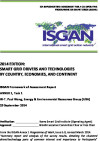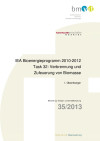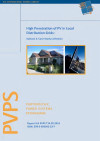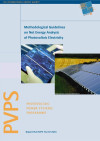Suchergebnisse
19th International Conference on Combustion Technologies and Physical Engineering
23. - 24. February 2017
Paris, FR
Interdisciplinary platform for researchers, practitioners and educators for Combustion Technologies and Physical Engineering.
2014 Edition: Smart Grid Drivers and Technologies by Country, Economies and Content

Der Bericht analysiert die unterschiedlichen Smart Grid Treiber und Technologien, innerhalb der ISGAN Mitgliedstaaten, auf nationaler und multinationaler Ebene.
Herausgeber: International Smart Grid Action Network
Englisch, 44 Seiten
Downloads zur Publikation
A membrane-free and practical mixed electrolyte direct borohydride fuel cell (2016)

Die Publikation beschreibt eine Direkt-Borhydrid-Brennstoffzelle basierend auf einem sehr einfachen und praktikablen Aufbau. Die Grundidee beruht darauf, dass der Brennstoff simultan als Elektrolyt fungiert. Die sogenannte Mixed Electrolyte Fuel Cell verzichtet auf die Verwendung einer Membran, was zu einer sehr einfach aufgebauten Direktzelle führt. Im Artikel werden die Herstellung sowie die Charakterisierung der Katalysatoren, der Elektroden und schlussendlich der Einzelzelle beschrieben.
Christoph Grimmer, Robert Zacharias, Maximilian Grandi, et al.
Herausgeber: © 2016 The Electrochemical Society
Englisch, 5 Seiten
IEA Bioenergieprogramm 2010-2012 Task 32: Verbrennung und Zufeuerung von Biomasse

Schriftenreihe
35/2013
I. Obernberger
Herausgeber: BMVIT
Deutsch, 45 Seiten
Downloads zur Publikation
Report "High Penetration PV in local Distribution Grids: Case-Study Collection" (2014)

Im Rahmen von Task 14 wurden Fallstudien zur Netzintegration von Photovoltaik in elektrischen Verteilnetzen erarbeitet. Daten aus 11 Ländern weltweit wurden gesammelt und für eine vergleichende Analyse aufbereitet, welche in diesem Bericht zusammengefasst ist.
Herausgeber: IEA Photovoltaic Power Systems Programme
Englisch, 206 Seiten
Downloads zur Publikation
Seminar: InnoGrid2020+ The European Research and Development Dissemination Seminar
23. - 24. February 2012
Brüssel, BE
ENTSO-E, in conjunction with EDSO for Smart Grids, is holding a European R&D Dissemination Seminar at ENTSO-E´s premises in Brussels in the wider context of the European Electricity Grid Initiative (EEGI).
Workshop "Design, Systemintegration und Regelung von Wärmepumpen in nZEB"
16. Januar 2020
AIT Austrian Institute of Technology, Giefinggasse 2, 1210 Wien, AT
Beim Workshop erhalten Sie einen Überblick über die nationalen und internationalen Aktivitäten, ausgewählte nationale CaseStudies sowie Best Practice Beispiele. Es werden die Anforderungen der aktuellen OIB Richtlinie 6, die zur Erlangung des Niedrigstenergiestandards für Wohnbau und Bürogebäude führen, präsentiert und auch im Vergleich zu anderen EU-Mitgliedsstaaten diskutiert.
IEA EBC Annex 80: Framework to evaluate the resilience of different cooling technologies (2021)

Definition von thermischen Rahmenbedingungen und Standard-Benchmarks zur Evaluierung der verschiedenen Kühltechnologien um einen weltweiten Vergleich der verschiedenen Kühltechnologien zu ermöglichen.
Attia, S., et al.
Herausgeber: IEA Annex 80, Thermal conditions task force, SBD Lab, Liege, Belgien
Englisch, 18 Seiten
IEA AFC Annex 33 Webinar: CHP in the built environment: Natural Gas and/or Hydrogen?
14. May 2021
Online, AT
IEA AFC Annex 33 is an application-type annex with the objective to better understand how stationary fuel cell systems may be deployed succesfully in energy systems. This webinar is part of the annual Annex 33 meeting and will focus on the end-use aspects related to heat and power supply in the built environment (residential and commercial users and prosumers).
IEA Bioenergy Webinar - Resilient Biomass Supply Chains in the Post-COVID Recovery
3. June 2021
Online, AT
IEA Bioenergy invites you to participate in a free international webinar entitled "Resilient Biomass Supply Chains in the Post-COVID Recovery".
Digital Twin of a Dynamic Hardware Emulator: Challenges and Opportunities
6. December 2022
Online, AT
To meet the new challenges and maintain the reliability of the electrical grid with increasing share of static generation, innovative solutions are required. This lecture will present digital twin development challenges and opportunities of a dynamic hardware emulator that can be used for controller hardware in the loop (CHIL) testing.
IEA Bioenergy Task 39: Improvement opportunities for policies and certification schemes promoting sustainable biofuels with low GHG emissions – Part 1: A review of policy frameworks

Emissionsreduzierung und Klimaschutz sind die treibende Kraft hinter der Produktion und Verwendung von Biokraftstoffen. Infolgedessen sind die allgemeine Nachhaltigkeit und die geringere Kohlenstoffintensität des endgültigen Kraftstoffs zunehmend zu einer Priorität geworden.
Jinke van Dam Consulting and Sergio Ugarte
Herausgeber: IEA Bioenergy Task 39, 2022
Englisch, 241 Seiten
Downloads zur Publikation
Entwicklungsstand der Torrefizierung und deren Auswirkungen auf den Bioenergiemarkt
Der Task 40 der IEA-Bioenergy ist eine internationale Arbeitsgruppe, mit Fokus auf einen nachhaltigen internationalen Handel mit biogenen Energieträgern. Ein Beitrag im aktuellen Newsletter beschäftigt sich mit den zukünftigen Chancen Torrefizierung von Biomasse.
Die Ergebnisse des Workshops zum Thema "Biotreibstoffe der Zukunft" der IEA Bioenergy
Ziel des Workshops war es, die zukünftigen Perspektiven von Biotreibstoffen aufzuzeigen.
International Conference on Solar Heating and Cooling for Buildings and Industry
23. - 25. September 2013
Konzerthaus Freiburg, Konrad-Adenauer-Platz 1
79098 Freiburg, DE
The SHC 2013 conference offers a unique discussion platform for the international solar thermal community.
Methodological Guidelines on Net Energy Analysis of Photovoltaic Electricity (2016)

Netto-Energie-Analyse ist eine strukturierte umfassende Methode der Quantifizierung des Ausmaßes, in welchem eine Energieerzeugungstechnologie positive Energie-Bilanzen erreichen kann, d.h. nach Abzug des Energieeinsatzes, der zur eigenen Produktion notwendig war. Die neuen Guidelines geben der Anwenderin einen Leitfaden, wie diese Methode anzuwenden ist.
Herausgeber: IEA Photovoltaic Power Systems Programme
Englisch, 35 Seiten
Downloads zur Publikation
IEA Bioenergy Webinar - Contribution of sustainable biomass and bioenergy in Industry Transitions towards a circular economy (Oktober 2020)

Der Workshop vermittelte Beispiele für Strategien und Initiativen zur Nutzung von Biomasse in der Industrie beim Übergang zu einer Kreislaufwirtschaft und wendete sich dem Recycling und erneuerbaren Ressourcen zu. In 3 Sessions zu je 2 Stunden blieb auch viel Zeit für ausführliche Diskussionen, Fragen und Antworten sowie die Formulierung von Empfehlungen, die die Bereitstellung solcher Anwendungen erleichtern.
Herausgeber: IEA Bioenergy TCP, 2020
Englisch
IEA 4E EMSA: Report on the EMSA Survey on digitalisation in electric motor driven systems (2021)

Dieser Bericht fasst die Ergebnisse der EMSA Umfrage zu Digitalisierung in elektrischen Motorsystemen zusammen.
Konstantin Kulterer
Herausgeber: IEA 4E- Annex Electric Motor Systems
Englisch, 22 Seiten
Downloads zur Publikation
IEA Bioenergy Intertask Projekt Bericht: Roles of bioenergy in energy system pathways towards a “well-below-2 -degrees-Celsius (WB2)” world (2020)

Der Bericht stellt einen Workshop Report und eine Zusammenfassung der vorgetragenen Studien dar. Der Workshop wurde im Rahmen des Intertaskprojekts abgehalten, in dem der Beitrag von Bioenergie zu einer Reduktion der Treibhauseffekt-relevanten Emissionen beitragen kann.
Thrän D, Cowie A, Berndes G, et el.
Herausgeber: IEA-Bioenergy TCP
Englisch, 127 Seiten
Downloads zur Publikation
IEA 4E Workshop - Addressing product lifetime, repairability, and resource efficiency: what can we learn from current trends in European product policy
21. September 2023
Online, Lund, SE
This workshop provides an opportunity to better understand and learn about a range of circular economy issues alongside energy efficiency product policies in the EU. The increasing awareness of the influence of product lifetimes on related GHG emissions and other environmental issues is giving rise to policies to promote durability and repairability.
